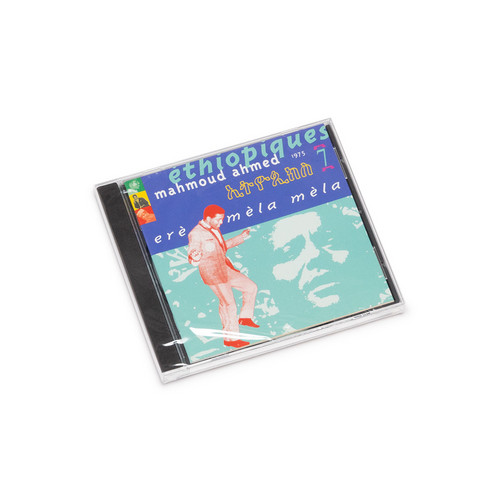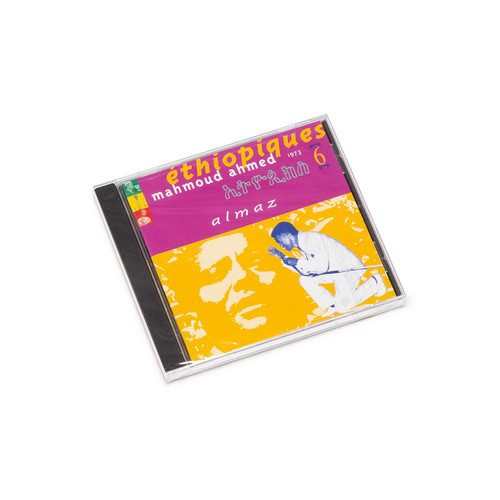Folk /
Éthiopiques 10: Tezeta - Ethiopian Blues & Ballads
*2024 stock* Emptiness, melancholy, nostalgia; doom and gloom, morbid musings; heartache or homesickness: such is the stock in trade of the misery and mournful memories expressed by the song Tezeta - Ethiopia's majestic hymn to the blues. Etymologically, the word itself means memory, nostalgia, and several Ethiopian authors have used Tezeta as the title for their memoirs. For Ethiopians, it is the Tezeta genre that seems to capture the essence of the blues.
Éthiopiques 9 (1969-1974)
*2024 stock* The Alèmayèhu songs already presented in Ethiopiques 3 and 8 have given a foretaste of this outstanding stylist of Ethiopian pop, a singer as remarkable for his frenetic rock numbers as for his heartrending ballads. By dint of rampant Americanism, he earned himsef such nicknames as The Ethiopian James Brown or the Abyssinian Elvis. With his dazzling stage presence, nimble voicebox and wicked pompadour, he is a strutting show-off, straight out of American Graffiti or Saturday Night F…
Éthiopiques 8: Swinging Addis
*2024 stock* In the 1960s there was a Swinging Addis just as there was a Swinging London. In Ethiopia, as in Europe bor the USA, the first generation born after the war made their noisy, colourful breakthrough onto the scene. A veritable cultural revolution rather than a simple generational conflict. With music as its detonator and its common denominator. This volume aims to collect the clearest examples of soul, R'n'B and even twist in the recordings of the Ethiopian 'sixties'. The quintessence…
Éthiopiques 7: Erè Mèla Mèla
*2024 stock* Erè mèla mèla was the very first record of modern Ethiopian music released in Europe (Crammed Discs, Brussells, 1986). It is only logical that it should be reissued today, expanded and remastered, in the Ethiopiques series. This volum 7 of Ethiopiques includes all of the Mahmoud Ahmed's recordings released in 1975 by Kaifa Records, i.e. the LP KF 20 plus 2 tracks released on another 45 and two additional songs included in the first Crammed release, two masterpieces from an album rel…
Éthiopiques 6: Almaz
*2024 stock* For many years everything we knew about Mahmoud Ahmed (and Ethiopian music in general) was limited to the cult album Erè Mèla Mèla (Ethiopiques 7 CD 829802), recorded in 1975 but released for the first time in Europe in 1986. Mahmoud's first LP, Almas ("Almaz men eda nèw"), recorded two years before Erè Mèla Mèla, now bears new witness to the talent of one of the greatest Ethiopian artists of the past 35 years.
Éthiopiques 4: Ethio Jazz & Musique Instrumentale 1969-1974)
*2024 stock* In the Ethiopian musical world, Mulatu Astatqé is a typical, totaly unique personality, a legend unto himself. For 30 years, he has been an inescapabe presence, a virtual statue casting a long shadow over the Ethiopian scene. His true singularity resides in his efforts in instrumental music in a country where musical culture and tradition are strangers to it. Note: Jim Jarmush put some of these hypnotic instrumentals to great use in the soundtrack of his film Broken Flowers
Éthiopiques 3: Golden Years Of Modern Ethiopian Music 1969-1975
*2024 stock* The Amha Records label issued approx 250 tracks in six years (1969-1975). 8 songs on this "Ethiopiques 3" CD are accompanied by bands affiliated with the Police. Indeed, until the very end of the 1960s, Ethiopia had no independant modern bands. Musical life was wholly dominated by the institutional bands attachd to either the Imperial Body Guard, the Police, the Army, the ciry of Addis Ababa, Agher Feqer Mahber or the Hayle Sellasie Theatre. Each of these institutions developed seve…
Éthiopiques 2: Tetchawet!
*2024 stock* Originally wandering minstrels, sharp-tongued peddlers who roamed the old Abyssinian countryside, many azmaris more or less settled down after the founding of Addis-Ababa just over a century ago. The cleverest of them quickly understood that they should set up their own businesses and take a cut on the drinks, instead of getting by on tips earned singing their way from one bar and tedjbèt (taverns serving tedj, the local mead) to another. (…) They have taken over the city by giving …
Éthiopiques 1 - Golden Years Of Modern Ethiopian Music 1969-1975
*2024 stock* 1969-1978. The main body of Ethiopian records was produced in less than one decade: all in all, just under 500 45s and around 30 LP albums. Amha Eshèté, creator of the Amha Records Label, was the driving force behind this brief creative burst and one of the main founders of the modernist movement, which swept the Ethiopian scene during the end of the rule of the Emperor Haile Sellassie. In six years (1969-1975), Amha issued approx 250 tracks. From his first recordings, he dispayed a…








